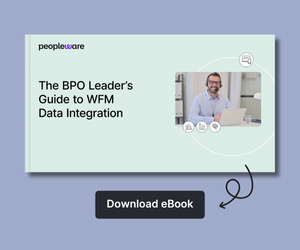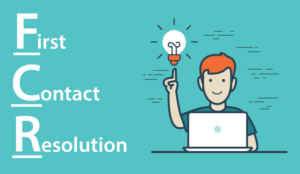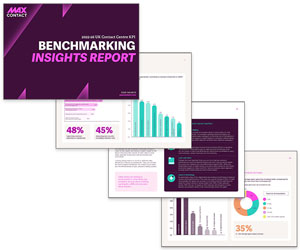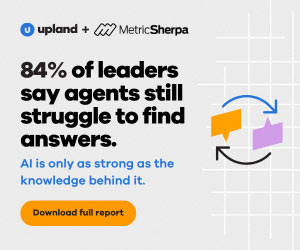Our latest What Contact Centres Are Doing Right Now report showed that First Contact Resolution (FCR) is being measured by over 60% of contact centres – highlighting a strategic emphasis on delivering a consistently fast and quality customer experience, every time.
But how do you improve this critical metric to drive all-round better service?
We asked our panel of experts to find out…
15 Ways to Improve First Contact Resolution (FCR)
1. Ask Yourself “Is Our Agent Rewards System Based on the Wrong Criteria?”
By setting up unreasonable time pressure or even a rewards system that’s based on the wrong criteria you are creating an environment where the agent’s metric is more important than resolution of the customer’s issue.
Under pressure, agents can cut corners; they could misdiagnose the issue or solve half the problem, missing cues or rushing the customer. All these things can cause failure demand.
Contributed by: Spencer Tidd, Principal Solutions Consultant in Contact Center Solutions, Enghouse Interactive
2. Break Down Your FCR Metrics by Agent, Issue Type, and Channel to Identify Trends

To make a real impact, FCR should be treated not just as a number but as a guide for coaching, development, and continuous improvement.
Break down your FCR metrics by agent, issue type, and channel to identify trends. Is one team struggling with technical issues while another excels at handling returns? Does one agent consistently drive higher repeat contact rates on policy-related calls?
Combine these insights with quality monitoring to pinpoint where the resolution process is falling short – whether it’s poor explanation, lack of ownership, or missed follow-ups. Use this data to fuel targeted coaching conversations, backed by real examples.
Contributed by: Tatiana Polyakova, COO, MiaRec
3. Encourage Agents to Use Probing Questions to Better Understand the Root Cause

Encouraging active listening and probing questions helps agents understand the root cause of a customer’s issue the first time.
Also, celebrate improvements to build a culture of continuous learning and accountability. When agents feel supported and customers feel heard, resolution rates naturally improve.
Contributed by: Tara Aldridge, Strategic Services Director, Vonage
For advice on using probing questions in customer conversations, read our article: 15 Examples of Probing Questions for Customer Service
4. Get on Top of Your Call Volumes to Stop Agents Rushing Through Interactions

A major reason first contact resolution (FCR) suffers is when demand exceeds staffing capacity. This causes agents to rush through interactions.
Accurate forecasting helps mitigate this by predicting contact volumes with precision, based on historical trends, seasonality, and known events.
When teams can anticipate demand, they can prepare adequately, ensuring the right coverage during peak periods. This allows agents the time and focus they need to resolve issues on the first try.
Accurate forecasting also supports proactive planning, from training needs to channel allocation, leading to more confident agents and fewer repeat contacts.
Contributed by: Isabel Lim, Marketing Manager, Peopleware
5. Make Sure Your Agents Know HOW to Use the Tools You’re Giving Them

Agent empowerment isn’t just about giving agents tools to help them do their job well – it’s about making sure they know how to use them!
For example, when it comes to knowledge management, it’s critical to know:
- Can they get to the database?
- Do they understand the database?
It’s all too easy to assume that “your scripts are here”, “if you have a question, the answer is here…“, but they are just the tools.
It’s no good to anyone if no one knows how to use them, so make sure your agents also have the appropriate training to benefit from the tools you are providing them with.
Contributed by: Sue Duris, Principal Consultant at M4 Communications, Inc.
6. Switch Your Approach From Generic Coaching to Targeted Agent Development

When we take time to analyse call drivers, we uncover the real opportunities to streamline journeys and empower agents.
But insights alone aren’t enough – agents need the right tools and training to resolve issues with confidence and speed. That means moving beyond generic coaching to targeted development based on actual call patterns and behaviours.
This is where technology can also bring context to the forefront: customer history, interaction data, and next-best-action guidance should all be available at a glance. When agents have this information at their fingertips, they can deliver faster, more accurate resolutions.
Contributed by: Florian Garnier, Product Marketing Manager, Calabrio
7. Get Every Conversation off to the Best Start by Routing Enquiries to the Most Qualified Human Agent

Customers are rapidly shifting to digital channels, and their expectations are higher than ever. They want the ability to self-serve, expect you to recognize and understand them, and they demand 24/7 support – often outside of traditional contact centre hours.
This is where asynchronous messaging and AI-driven automation are critical in today’s world.
A recent success story comes from Hastings Direct, which proactively adapted to this shift. The company redesigned a major IVR routing policy, introduced asynchronous messaging as a new customer channel, and enhanced their mobile app to enable seamless authentication.
Enhanced IVR and smarter call routing based on policy details and customer lifestyles ensured customers nearing policy expiration were instantly connected to renewal teams – with one IVR improvement alone reducing call transfers by 98%.
Today, many leading organizations are following suit – supporting customers across digital channels and leveraging AI-driven automation to understand intent, answer FAQs, fulfil requests, and route enquiries to the most qualified human agents.
The result? A faster, more convenient experience that meets the elevated expectations of the modern consumer from first contact.
Contributed by: Richard Bassett, VP of CX Automation & AI, NiCE International
If you are looking for expert advice on how to get your routing strategy off to a great start, read our article: Enhance FCR With Smart Routing
8. Train Agents to Project Confidence in Their Voice

Agents who sound really confident and competent over the phone help improve First Contact Resolution (FCR) rates too.
Whether they are confidently saying “The full processes will take a week” or “You’ll get a confirmation letter, but you don’t need to do anything other than read it and keep it safe”, this all helps to clarify and reassure customers about what will happen next, so they don’t feel the need to call back.
This is particularly one to keep an eye on with new starters, because if you’ve got someone who is feeling unsure about the process, it will come through in their voice, and the customer will likely call back later on to double-check the information with another agent.
Contributed by: Adam Boelke, Founder of the Alignment Advantage Group, and author of the “7 Cs to Success” mastermind course on leadership & culture
9. Proactively Anticipate Problems That Might Lead to Another Call

Improving FCR goes beyond just solving the problem at hand – it’s also about preventing future issues before they arise.
By taking a proactive approach, your team can follow up with customers to ensure their concerns are fully resolved and even anticipate potential problems that might lead to another call.
Insights from customer conversations can reveal common triggers and patterns that predict follow-up contact, allowing your team to step in early.
That could be sending a quick confirmation, providing clear next steps, improving a process that’s causing friction, or checking in before an issue escalates; personalized and proactive actions don’t just reduce repeat contact – they build trust, strengthen loyalty, and drive higher customer satisfaction.
Contributed by: Frank Sherlock, VP of International, CallMiner
10. Stop Making Assumptions About Why Customers Are Reaching Out to You

Avoid making assumptions about why customers are reaching out to you. Limiting or not revisiting customer options in IVRs (interactive voice response) and chat flows can hinder resolution.
Customers need the freedom to explain their issues openly, while agents require the flexibility to listen and act without arbitrary system constraints.
First Contact Resolution isn’t solely influenced by the moment agents pick up interactions!
AI and machine learning tools can help you predict and pre-empt contact. You’ll often know why a customer contacts you before they do based on upstream service failures, which allows for proactive communications to manage expectations better.
In the worst-case scenario, customers arrive with the necessary information to resolve issues on the first attempt. In the best case, it can even reduce the need to contact altogether.
Contributed by: Lewis Gallagher, Senior Solutions Consultant, Netcall
11. Review Your Rigid Tier Structures Across the Team

Equip your frontline agents with the tools, access, and training needed to handle more complex queries.
Far too often, I hear of issues escalated unnecessarily due to rigid tier structures or lack of training. If your Tier 1 team can resolve Tier 2-level issues – like updating customer details or navigating integrated systems – you eliminate a huge number of repeat contacts.
Creating confident agents, giving them not just scripts but decision-making frameworks and access to data in real time, can make a considerable difference.
Also, encourage agents to seek help and training for areas they need help with, but reframe it so that it isn’t seen as areas of weakness or a failing. It’s about support and development.
Contributed by: Lisa Orford, Vice President for Contact Centre, 8×8
12. Find Out Why Some Agents Consistently Resolve Issues on the First Try While Others Don’t

Improving First Contact Resolution starts with understanding the behaviours behind the metric. Why do some agents consistently resolve issues on the first try while others face more repeat contacts? What patterns suggest customer confusion or unmet needs?
Performance tools powered by AI can identify behavioural patterns and skill gaps linked to low FCR, enabling managers to take targeted action. Meanwhile, embedded microlearning helps agents refine their habits and build the skills they need to perform better.
FCR improves not just when information is available, but when behaviours evolve. That happens when both agents and managers are equipped to learn, adapt, and act on what’s really driving – or holding back – resolution.
Contributed by: Michael Ciancio, Chief Marketing Officer, Centrical
13. Design Self-Service Options to Prevent Contacts in the First Place
Self-service tools can either improve FCR or sabotage it. When customers try to resolve an issue themselves and fail, they arrive at the contact centre frustrated and harder to help.
To avoid this, build self-service experiences using real conversation data to guide content, structure, and language.
Identify the top reasons customers call after attempting self-service and focus on those friction points first.
- Are instructions unclear?
- Are there too many steps?
- Is key information buried or missing altogether?
By aligning self-service flows with the way customers actually speak and search, you increase resolution rates and prevent unnecessary follow-ups.
Contributed by: Tatiana Polyakova, COO, MiaRec
14. Identify Patterns for When Certain Issues Are Most Likely to Occur

FCR percentages improve when the right agent with the right skills and knowledge is available to deal with each issue.
This is where technology can help. Use AI to analyse all customer interactions for insights into repeat calls, with recommended solutions. This analysis of the Voice of the Customer (VoC) can also identify patterns, like when certain issues are most likely to occur during the day or week.
Also use those customer interactions to perform AI-automated agent evaluations, which can identify and help guide an agent training strategy, including programmes that teach agents how to improve engagement and resolve issues on the first attempt.
Contributed by: Spencer Tidd, Principal Solutions Consultant in Contact Center Solutions, Enghouse Interactive
15. Make Sure Everyone Agrees What Good Looks Like
Finally, make sure everyone is on the same page about what good looks like! If the contact centre thinks FCR is measured with a repeat caller in the first 30 days, but the board thinks it’s 15 days – everyone is off to a bad start.
You also need to be sure to filter out what’s a normal callback – as part of a standard process – and what’s actually a problem.
Only with a clear picture of what’s happening and what you are aiming for can FCR be used as a meaningful metric – from which real improvements can be made.
Contributed by: Adam Boelke, Founder of the Alignment Advantage Group, and author of the “7 Cs to Success” mastermind course on leadership & culture
For more great insights and advice from our panel of experts, read these articles next:
- Are Chatbots the Tech We All Love to Hate?
- 10 Game-Changing Ways Emotion Will Shape the Future of CX
- New Ways to Empower Agents in 2025
- From Chaos to Control! Why Contact Centres Are Prioritizing WFM Solutions
Author: Megan Jones
Reviewed by: Jo Robinson
Published On: 13th May 2025 - Last modified: 13th Nov 2025
Read more about - Customer Service Strategy, 8x8, Adam Boelke, Calabrio, Call Handling, CallMiner, Centrical, Customer Experience (CX), Customer Service, Enghouse Interactive, First Contact Resolution (FCR), Florian Garnier, Frank Sherlock, Isabel Lim, Lewis Gallagher, Lisa Orford, Metrics, MiaRec, Netcall, NiCE, NiCE CXone, Peopleware, Richard Bassett, Service Strategy, Sue Duris, Tara Aldridge, Tatiana Polyakova, Top Story, Vonage





















